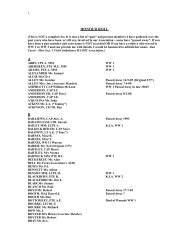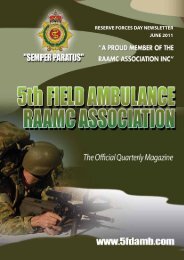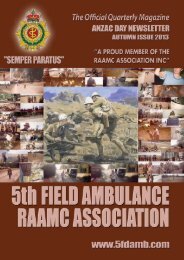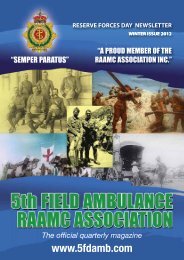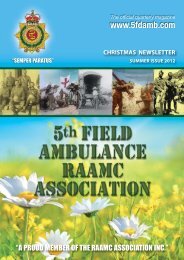2010 Paulatim Magazine - RAAMC Association
2010 Paulatim Magazine - RAAMC Association
2010 Paulatim Magazine - RAAMC Association
You also want an ePaper? Increase the reach of your titles
YUMPU automatically turns print PDFs into web optimized ePapers that Google loves.
Water for some R & R. As I had sustained burns to my head and<br />
shrapnel injuries to my rear I to was evacuated. Arrangements would<br />
be made for those who had suffered injuries in the attack on the<br />
Galahad to be treated and evacuated out of theatre of operations.<br />
It was at this point that I realised that I had sustained some injuries and<br />
a flood of relief came over me with the knowledge that I was going<br />
home. After a hot meal and shower on board the ship an<br />
announcement came over the tannoy informing the following personnel<br />
to report to the deck for transfer to a helicopter. My name was on the<br />
list. This was it I was going home!<br />
PAULATIM<br />
30 minutes later I found my self back on dry land. With my SMG in my<br />
hand and weighted down with ammo and medical equipment. The final<br />
push to free the Falklands was on and I wasn’t going home just yet.<br />
Evacuation of battlefield casualties.<br />
own beret and using a rusty nail secured it to the cross. We then<br />
lowered him in to the grave and the padre said a few words before we<br />
each saluted the 2IC for one last time.<br />
The final tab (march) to Stanley.<br />
For the next five days I found my self either working in the make shift<br />
dressing station at Fitzroy, collecting wounded from the various<br />
battlefields or providing close medical support to the Ghurkhas and<br />
Scots Guards as the mountains around Port Stanley were assaulted.<br />
During the assaults as we passed many of the wounded both our own<br />
and the Argentineans we would throw them a couple of dressings and<br />
tell them we would be back later until then they had to rely on self aid.<br />
The problems of casualty evacuation to the Regimental Aid Posts and<br />
beyond were immense. Due to the soft terrain vehicles could not be<br />
used so evacuation was reliant on stretcher bearers. In some cases the<br />
wounded soldiers had to walk considerable distances before receiving<br />
any treatment. Most engagements took place at night on remote hill<br />
sides in adverse weather conditions. Many soldiers, including ones who<br />
had lost limbs lay for many hours relying on self aid. We did not know<br />
it then but these conditions proved crucial to the survival rate of the<br />
wounded due to the extreme cold experienced. Where possible<br />
helicopters were used to evacuate casualties from the battlefield.<br />
All the wooden crosses in the cemetery had the beret of the solider who<br />
had died placed on them to help identify who they were and the units<br />
they served in. We could not do this for MAJ Nutbeam as his beret had<br />
been lost on the Galahad so I removed the RAMC Cap badge from my<br />
The Sir Galahad before being towed away and sunk as a War Grave.<br />
Almost two weeks after the cease fire the a Service of Remembrance<br />
was held on the deck of the Sir Tristrum while the Sir Galahad, which<br />
was still burning, was towed out to sea and sunk as a war grave.<br />
Scouse and Kenny were never going home.<br />
Two months later I returned to the UK from the Falklands. The journey<br />
down to the Falkland Islands which seemed like an eternity ago took<br />
three weeks, the journey back took two days It would be another two<br />
months before I was allowed any leave as on my return my section was<br />
still the Spearhead section and we were put on standby for another<br />
operational deployment. In October 1982 I was posted out of 16 Field<br />
Ambulance to the Junior Regiment Royal Signals Medical Reception<br />
Station.<br />
This was not the end of my Falklands experience however. In February<br />
1983, I became yet another casualty of the Falklands War after<br />
suffering a severe bout of Battle Shock now known as Post Traumatic<br />
Stress disorder PTSD. 250 British Servicemen were killed in the Falklands<br />
War and since then almost the same number have died as a result of<br />
PTSD related circumstances. Nor was this the last of my operational<br />
tours, but that is another story.<br />
By: Captain Andy Brayshaw <strong>RAAMC</strong><br />
PA U L AT I M – M A GAZINE O F T HE R OYA L A U S T R A L I A N A R M Y M E DICAL C O R P S – 2 0 1 0 6 7



